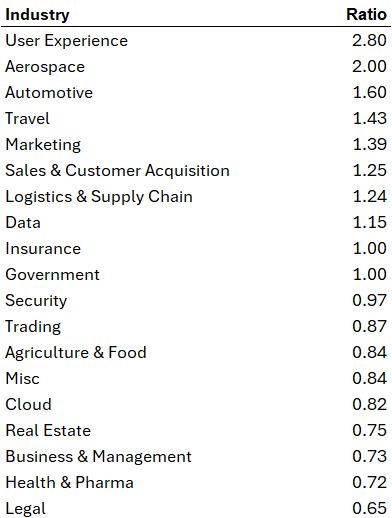
What Attracts Money? Part 1
| 4 min read | by Yugen Omer KoratIf you opened an AI startup now, should you get into?
I tried to answer this question by looking at the data.
I analyzed AI companies that received seed/pre-seed investments between May 2022 and May 2024, to find out their distribution by industry. I also did the same for those that were acquired in the first half of 2024 (that is, recent exits), and compared the results to see which industries are most likely to succeed.
I obtained the data with a Crunchbase search of companies that have “AI” in their title, and ended up with 1154 funded companies and 821 bought companies. I assigned each company a category based on what it does and which industry it targets by an iterative process of prompting followed by manual inspection. With every cycle, I inspected the results of the prompt by sampling, and then refined it over and over until every sample I inspected was correctly labeled. So semi-automation.
Most of the categories are self-explanatory, like Healthcare, Agriculture, and Finance. Some categories were slightly conflated, like Marketing, Sales & Customer Acquisition, and Business & Management, so I needed to refine the prompt to make sure it captures the right distinctions. But the most challenging ones were companies that build applications for improving machine learning/AI models or code infrastructure, since the industry in question is AI, and therefore in some sense every company deals with those things.
What I ended up doing is defining the following categories to handle those cases:
Data: Companies that use AI for data science applications, such as data analysis, information retrieval, and question answering.
Foundation Models: Companies whose business is training and improving industry-agnostic machine learning and natural language processing applications, such as sentiment analysis, text classification, and chatbots. That is, their product is applicable regardless of the industry as it operates on the algorithm level.
Code & Process Automation: Companies that use AI for building development tools whose end users are developers themselves, meant to streamline and improve the efficiency of their development processes.
By the way, those are the exact words I used in my final prompt as well.
There was also a Misc category that spanned companies that do something either so specific that it doesn’t fall into any of the other categories, or their description was unclear or lacking information.
In the next part in this series, I will include examples from all these remarkable categories, but for now let’s move on to the results.
Discussion

These results, of course, are very preliminary and do not, by themselves necessarily indicate any emerging trends. But they do suggest possible ones. Investors / entrepreneurs looking into AI startups should focus on industries that show a higher likelihood of acquisition relative to funding, and based on the results collected here, User Experience and Aerospace stand out with the highest bought over funded ratios, suggesting strong demand for solutions in these areas. Emerging opportunities include Automotive and Marketing, both of which show significant acquisition activity, indicating that companies in these sectors are attractive to acquirers.

However, some sectors like Finance and Compliance & Risk Management, despite having many startups, show lower acquisition ratios, which implies potential challenges in achieving successful exits. Foundation Models and Code & Process Automation, though crucial to AI infrastructure, also have lower acquisition rates, suggesting these areas may require longer-term investments or face competition from established players.
In the long term, investors should consider industries where AI integration is expected to rise, such as Healthcare and Data Management, which consistently attract funding. As AI becomes more embedded across sectors, future trends could favor niche, specialized applications, which may lead to increased acquisition activity in currently underrepresented sectors like Energy & Environment and Education. Diversifying investments across high-acquisition sectors and emerging fields could offer balanced, strategic opportunities.
